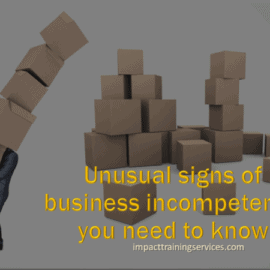Last Updated on April 12, 2024 by Lorna Barrow

“Y’all talking about change management success?” asked my friend and business colleague.
It’s as elusive as my last boyfriend!” She continued in response to my wide-eyed, unblinking stare.
To tell the truth, we weren’t even aware that she was listening to us, so her comment took us completely by surprise.
Even so, I am not going to comment on her elusive boyfriend.
But I do have quite a bit to say about change management success for small businesses like hers. And yours.
You see, I’ve been quietly observing how small business owners go about implementing change in their businesses.
No sooner as you decide you need to change something in your business, you go in search of some hifalutin approach, that you discovered had worked for some big corporation.
And that’s when you run into trouble.
I can’t say it often enough.
Small businesses are not scaled-down versions of big business. They are unique and different in many ways and as such, they require solutions which are appropriate for their circumstances.
Change management is no different.
But before we can even discuss the success of change management, let’s be clear about the nature of change management itself.
Definition of Change Management
First, let’s look at what change management is NOT:
1. A one-time event – It’s a continuous process that requires ongoing effort and attention to ensure successful implementation and adoption of changes within your business.
2. A one-size-fits-all approach – It requires tailoring strategies and tactics to the specific context, culture, and nature of the change being implemented.
3. A quick fix – It requires time, effort, and commitment to effectively manage change and achieve desired outcomes.
4. Just about making changes – It involves a structured approach to shift individuals, teams and businesses from a current state, to a desired future state while minimizing resistance and maximizing benefits.
Following on from the above, we can conclude that:
1. Change management refers to the process of introducing and implementing changes within a business in a structured and controlled manner.
2. It focuses on managing the people side of changes to ensure successful outcomes by minimizing disruptions, engaging employees, and facilitating adaptation to new ways of working.
3. The primary goal of change management is to maximize the benefits of change while minimizing potential disruptions and resistance.
But even as we clarify change management, as is discussed in the short video below, change is like a jungle with lots of unknown vegetation.
And like “Alice” you will feel like you need some sort of superpower to get you through the process.
6 Steps to change management success
So how do you implement any change in your business in such a way that you avoid the agony of getting it all wrong?
Simple.
You start by engaging your people (impacted employees) early and in some meaningful way. This must be part of your collection of business solutions.
If you don’t start by engaging your team early, you’re just asking for a difficult process with much resistance and a myriad of other “people” issues.
So, let me show you 6 practical ways you can use to ensure you actively involve your people in the process, and enhance your chances of success at the same time.
1. Understand the impact of change on your employees
As I mentioned earlier, you will sometimes choose to implement some changes to grow your business.
In other cases, because you’re part of a wider business environment, you will be forced to make changes in response to issues in that external environment.
Whatever the reason for the change, here are some of the ways it will impact your people. They will be:
1. resistant to change due to anticipated loss of many aspects of their existing circumstances
2. forced to think, act and perform differently
3. uncomfortable and unsure when you ask them to change
4. unable to handle lots of change all at once
5. concerned about the available resources (business and individual) to support the change
6. fearful about loss of employment
7. apprehensive about changes in job roles
8. fearful that they won’t be able to learn the new skills the change might require
When you take these things into consideration very early in the process, you are actually laying a foundation for your own change management success.
2. Check YOUR readiness for change
It is common for owners and leaders to see themselves as managers of change.
And this is alright.
But in doing so, you also see yourselves as separate from the actual change.
Now, this becomes a problem you did not intend.
What you are really doing is unintentionally creating a lopsided approach which can undermine your efforts, right out of the box.
It makes sense then, that you acknowledge that you are equally a part of the change process, as your employees are.
Therefore, you need to examine your readiness for the change and your capacity to lead the change management process.
So here are some self-reflection questions to help you look at your own readiness for the change, and your capacity to lead it:
1. Am I mentally ready for the changes that must be made?
2. Do I have the required leadership skills to guide this change?
3. Do I fully understand the context in which I lead?
4. Do I have or can I locate the resources to allocate to this process?
5. Will I lead the process myself or will I hire a Change Management Expert?
6. Do I have the communication skills to sell the ideas to get the required buy-in?
7. How strong are my decision-making and problem-solving skills?
8. How good am I at accepting feedback and good ideas?
9. Have I truly considered the consequences of this change attempt failing?
10. What methods will I use to handle the likely conflict or fallout from the change?
3. Share the reason for the change
Small business people are notorious for holding things “close to the chest”.
Here is an example of what I mean.
You come to me for help with some aspect of your business. No problem there. But right after the handshake, you ask me to sign a non-disclosure agreement.
Really!? Because you have not yet given me anything to disclose!
When you are about to engage in change management and want successful outcomes, be open with your team.
Being open does not mean that you share confidential information. However, it does mean that you share things like:
1. Why the change is necessary
2. The benefits of the change
3. The consequences of not changing
4. The likely pain that might result from the process and the outcomes
5. An initial roadmap for the change
6. A vision of the environment after the change
So please, let your people know why the change is necessary, how it will be rolled out, how it will impact them.
When you do, resistance will be at a minimum and the likelihood of good results will be higher.
4. Ensure your management team is on board
This is where your change management success runs into trouble…when you don’t make sure you have management buy-in.
But why is this even an issue?
Because many business owners believe that the agreement of their managers is automatic. As a matter of fact, many of you often declare: “that’s what they are paid for!”
I’m not sure that’s true. They might be paid for managing several areas of the change but not necessarily to agree with it or support it.
If you don’t have your management’s buy-in, this could be a real problem.
Look, in this process, you need your management team out there stumping for you. They are the ones who will be required to:
1. Communicate the vision
2. Instill a sense of urgency
3. Encourage the team to take risk
4. Keep morale high and resistance low
5. Lead by example and model potential new behaviour
6. Address any roadblocks
7. Manage the implementation plan
8. Recognize/reward the employees involved in the change
Just imagine the potential for confusion, resistance and eventual failure, if you don’t have the support and buy-in of your management team.
5. Implement a communication plan
When you are going through a change management program, the water cooler and the grapevine CANNOT be your chief communication tools.
You must aim for effective communication. This must be driven by a thorough understanding of your audience and delivered through the right tools and channels.
You know by now that proper communication reduces resistance, stress and feeling of hopelessness. You also know that people have to be exposed to ideas or concepts several times before they really get it.
Therefore, your communication plan must be developed at the same time as your implementation plan. It cannot be an afterthought.
In designing your plan, you have to consider:
1. Information requirements – such as content; what will change and what will not.
2. The recipients – management team; other team members; customer; suppliers and even family members.
3. Plan design – media choices; tone; actual content of messages; timing; spokespersons.
4. Implementation methodology – roll out; phasing; feedback mechanism; changes/updates methods.
Just trying to embrace all the possible combinations of the required communication approaches can leave you struggling for breath.
But think of the main benefits…
1. Having the info about the change and how you’re managing the change readily available
2. Lowering the resistance to your efforts
3. Ensuring a shorter lull in non-productive time between phases
Trust me, it will be well worth it.
6. Support your people with training and coaching
One of the best things you can do to up the ante on you change management success, is to train and coach your people as part of the process.
While you might understand why intuitively or from what you have read above, they are some practical reasons why change-related training and coaching are necessary. They:
1. promote employee engagement in a very tangible way
2. increase the rate of change management success
3. reduce employee turnover during the change process
4. protect revenue and profits by providing stability as you change
5. prepare your employees not only for the change but also to be advocates of the change
6. facilitate the implementation of your communication plan
7. reduce the need for any crisis management skills
8. stabilize productivity if the training includes how to deal with distractions and roadblocks during the process
With regards to coaching, you should use it to create a support network.
This is where you encourage team members to go to discuss the change and any challenges they are having with the change.
This network should be led by a “coach” who will help employees to work through and solve these problems.
Another role for the coach is to encourage team members to set goals for how they will deal with the change, post training.
They should check-in with the team members periodically to ensure they remain on track towards their goals.
Establishing a mentorship programme or “Circle of Experience” is also a great asset in this regard.
Your next steps to change management success
So there you have it!
I have shared my thoughts with you on how to raise your chances of change management success.
To be honest, what I have shared is more than my thoughts.
They are the practical approaches I use, when I help small business persons make changes in their businesses.
You can use your judgement and how flexible you want to be to decide which you will implement first.
OR…
If you find it all too much and you want to outsource the entire process, that’s okay too.
In that case, just use the information to guide your choice of consultant.
Whatever you choose…here’s wishing you every success!




